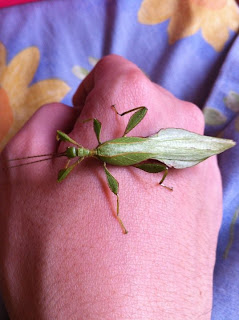Hey guys!
Yeap, you heard it here, a leaf that walks!!! Although, to be honest I don't think I will be taking mine for any walks anytime soon...and if we're going to be technical it is really not a leaf but rather an insect that looks remarkably a lot like one! Walking leaf insects, like their close relatives the walking sticks come under the insect order of phasmotodea, more commonly known as "'phasmids". The term phasmid itself originates from the Greek word "phasma" meaning an apparition or phantom which is derived from the insect's uncanny resemblance to twigs, sticks, leaves and various plant matter which make them extremely difficult to spot in the wild. In captivity though, leaf insects can quite commonly be found in most butterfly houses and insectariums around the world, often showcased as exemplary specimens of insect camoflauge and mimicry.
Yeap, you heard it here, a leaf that walks!!! Although, to be honest I don't think I will be taking mine for any walks anytime soon...and if we're going to be technical it is really not a leaf but rather an insect that looks remarkably a lot like one! Walking leaf insects, like their close relatives the walking sticks come under the insect order of phasmotodea, more commonly known as "'phasmids". The term phasmid itself originates from the Greek word "phasma" meaning an apparition or phantom which is derived from the insect's uncanny resemblance to twigs, sticks, leaves and various plant matter which make them extremely difficult to spot in the wild. In captivity though, leaf insects can quite commonly be found in most butterfly houses and insectariums around the world, often showcased as exemplary specimens of insect camoflauge and mimicry.
 |
| Gray's Leaf Insect (Phyllium Bioculatum), can you spot it? |
 |
| Female leaf insect (P. Bioculatum). |
 |
| Male leaf insect (P. Bioculatum). |
As you can see the males look considerably different from the females. Indeed they are not only smaller in stature (measuring almost half her size) but live significantly shorter lives as well! Then again, I suppose in a society where females no longer have any need for males to reproduce, its only a matter of time before they are rendered completely obsolete. A scary thought there but one that has, nontheless been accomplished in the wild by several species of stick insects and even lizards! Males also posses a pair of hindwings which can be used for flight (a trait that is entirely absent in the females).
 |
| My very own walking leaf |
 |
Meanwhile I honestly wonder why not more people have come to raise leaf-insects and other phasmids as pets. I mean, they have, comparatively, as many the interesting and intriguing physical attributes as other more commonly kept invertabrates (say scorpions or tarantulas) and yet, none of the menacing venom and/or poison.
 |
| What's more, isn't this just a face you can't resist? |
My little green monster and me, we go everywhere together~

3 comments:
Amazing photos!! Love the wings on the male. And interesting info.
i guessed that you are an insects lover! lol... anyway nice pics..
Do they bite.? I have one but his an indian walking stick
Post a Comment